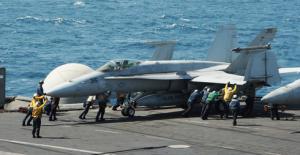ISISU.S. has killed 45,000 ISIS militants since September 2014; 3 U.S. soldiers killed by ISIS
The U.S.-to-ISIS “kill ratio,” that is, the number of American soldiers killed relative to the number of killed ISIS militants, is a staggering, and unprecedented, 15,000-to-1. The U.S. military claims to have killed 45,000 militants, including a number of senior leaders, since the September 2014 launching of the U.S.-led coalition campaign against ISIS. Only three U.S. troops have been killed in the campaign. The U.S. killed 6,000 militants between September and December 2014, and 39,000 between January 2015 and July 2016.

U.S. carrier-based aircraft being readied for mission // Source: theconversation.com
The U.S.-to-ISIS “kill ratio,” that is, the number of American soldiers killed relative to the number of killed ISIS militants, is a staggering, and unprecedented, 15,000-to-1. The Washington Post reported that the U.S. military claims to have killed 45,000 militants, including a number of senior leaders, since the September 2014 launching of the U.S.-led coalition campaign against ISIS. Only three U.S. troops have been killed in the campaign, making the US-to-Isis “kill ratio” 15,000-to-one.
President Barack Obama earlier this year declared that ISIS had lost large swathes of territory, and the Islamist group’s followers “realize their cause is lost.”
Obama said ISIS had lost 40 percent of its “caliphate” in Iraq and 10 percent in Syria, and had suffered numerous financial setbacks.
Military analysts note that better intelligence has led to a more effective coalition campaign against ISIS: in the four month from September to December 2014, the coalition strikes killed 6,000 ISIS militants – or about 1,500 a month. In the eighteen months from January 2015 to July 2016, the number of militants killed was 39,000 – or about 2,100 a month.
Better intelligence has also led to effective strikes against ISIS leadership. In the last seven months, precision airstrikes have killed the Islamist group’s second-in-command, Abu Muhammad al-Adnani; the group’s No. 3 — defense minister Omar al-Shishani; the organization’s No. 4 — finance minister Haji Iman; and ISIS’s No. 5 — Baghdadi’s formal deputy, Abu Ali al-Anbari.
Over the weekend, ISIS has also lost the last swath of territory it held under its control along the Syria-Turkey border. This is major loss for the Islamist group, isolating it from the world, hampering its ability to bring in foreign recruits, and making it much more difficult to smuggle people and materiel out.
A large Turkish invasion, accompanied by massive artillery barrages and airstrikes, which was launched near the city of Jarablus on 24 August, has pushed ISIS forces back, allowing the Turkey-backed Free Syrian Army (FSA) to take control of the 91-km stretch of border territory.
The one-week Turkish military campaign has also allowed Turkey to achieve another goal: keeping the two Kurdish-controlled territories – one the east of the FSA-controlled area, one to the west – from uniting to form a de facto Kurdish autonomous region along the Syria-Turkish border.
